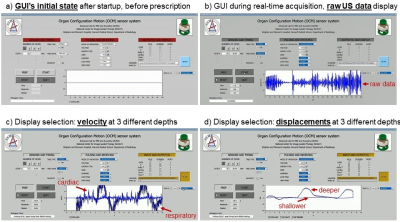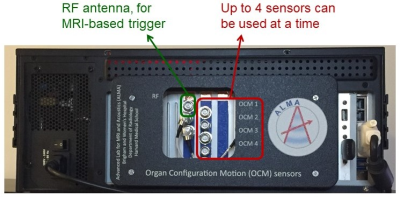Bruno Madore1, Cheng-Chieh Cheng2, and Frank Preiswerk3
1Radiology, Brigham and Women's Hospital, Harvard Medical School, Boston, MA, United States, 2Computer Science and Engineering, National Sun Yat-sen University, Kaohsiung, Taiwan, 3Amazon Robotics, Westborough, MA, United States
1Radiology, Brigham and Women's Hospital, Harvard Medical School, Boston, MA, United States, 2Computer Science and Engineering, National Sun Yat-sen University, Kaohsiung, Taiwan, 3Amazon Robotics, Westborough, MA, United States
An ultrasound-based sensor system was built that is compact, clonable and GUI-controlled. A key strength of these sensors is that they attach to the skin and can follow a patient through different procedures, possibly linking them in ways that take physiological motion into account.

Fig. 3: The sensor system is controlled through a GUI. Its initial state is shown in (a), and a snapshot of a real-time acquisition in shown in (b). Instead of raw data (b), one can select velocity (c) or displacement (d) for the GUI’s display window, and switch between display types during the real-time acquisition if so desired. Raw data are saved to file and can be retrospectively re-reconstructed and displayed, which happens to be how (c) and (d) were generated; note the gold color of the selected ‘retro’ button in (c) in (d), as opposed to its pale-blue non-selected color of (a) and (b).

Fig 1: a) A compact, clonable sensor system was developed for ultrasound-based sensors, to monitor physiological motion during diagnostic imaging. Up to four sensors can be used at a time (red arrow), and an RF antenna can be used for synchronization with MRI (green arrow). While this system is still one-of-a-kind, it was built to be clonable, to enable possible collaborations across institutions and geographical locations.
